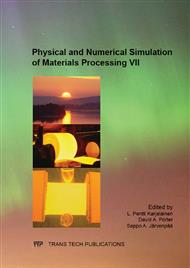p.176
p.183
p.189
p.194
p.210
p.218
p.224
p.230
p.236
Mathematical Modelling of Hot Rolling: A Practical Tool to Improve Rolling Schedules and Steel Properties
Abstract:
Most of the commercial metallic materials undergo at least one hot deformation stage during fabrication. Hot deformation processing leads to the production of plates, strips, rods, pipes and other shapes at lower overall cost when compared to the cold deformation/annealing route. Comprehensive study of the metallurgical phenomena during hot deformation has enormous potential application in the control of industrial rolling processes. Understanding of the microstructural and mean flow stress evolution lead to sound steel developments and innovative rolling schedules. The models predict parameters such as grain size, fractional softening (static and dynamic) and strain induced precipitation which are useful to improve rolling schedules. Effects such as incomplete softening and strain accumulation can be easily detected as well as their consequences on the final grain size and mechanical properties. In this regard, special attention must be given to steels, the most important metallic material in terms of history, present and future. In this paper, three hot rolling routes will be analyzed in order to produce high strength linepipe steels. Examples were selected on how the use of modelling during development stage can help to meet mechanical properties, mainly toughness and drop weight tear test. Firstly, it is presented a brief overview on mathematical models applied to hot rolling. Thin slab casting/direct rolling, hot strip mill and plate mill are exemplified in the present work. The development of new steel grades can greatly accelerated with the aid of modelling, which is an useful, low-cost technique.
Info:
Periodical:
Pages:
210-217
Citation:
Online since:
July 2013
Authors:
Price:
Сopyright:
© 2013 Trans Tech Publications Ltd. All Rights Reserved
Share:
Citation:


